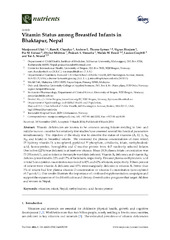| dc.contributor.author | Ulak, Manjeswori | en_US |
| dc.contributor.author | Chandyo, Ram Krishna | en_US |
| dc.contributor.author | Thorne-Lyman, Andrew L. | en_US |
| dc.contributor.author | Henjum, Sigrun | en_US |
| dc.contributor.author | Ueland, Per Magne | en_US |
| dc.contributor.author | Midttun, Øivind | en_US |
| dc.contributor.author | Shrestha, Prakash S. | en_US |
| dc.contributor.author | Fawzi, Wafaie W. | en_US |
| dc.contributor.author | Graybill, Lauren | en_US |
| dc.contributor.author | Strand, Tor A | en_US |
| dc.date.accessioned | 2017-04-26T11:25:03Z | |
| dc.date.available | 2017-04-26T11:25:03Z | |
| dc.date.issued | 2016-03-08 | |
| dc.Published | Ulak M, Chandyo RK, Thorne-Lyman AL, Henjum S, Ueland PM, Midttun Ø, Shrestha PS, Fawzi WW, Graybill, Strand TA. Vitamin status among breastfed infants in Bhaktapur, Nepal. Nutrients. 2016;8:149(3) | eng |
| dc.identifier.issn | 2072-6643 | |
| dc.identifier.uri | https://hdl.handle.net/1956/15712 | |
| dc.description.abstract | Vitamin deficiencies are known to be common among infants residing in low- and middle-income countries but relatively few studies have assessed several biochemical parameters simultaneously. The objective of the study was to describe the status of vitamins (A, D, E, B6, B12 and folate) in breastfed infants. We measured the plasma concentrations of trans retinol, 25 hydroxy vitamin D, α-tocopherol, pyridoxal 5′-phosphate, cobalamin, folate, methylmalonic acid, homocysteine, hemoglobin and C-reactive protein from 467 randomly selected infants. One in five (22%) was deficient in at least one vitamin. Mean (SD) plasma folate concentration was 73 (35) nmol/L, and no infant in the sample was folate deficient. Vitamin B6 deficiency and vitamin B12 deficiency was found in 22% and 17% of the infants, respectively. Elevated plasma methylmalonic acid or total homocysteine concentration was found in 82% and 62% of infants, respectively. Fifteen percent of infants were vitamin A deficient and 65% were marginally deficient in vitamin A. Fewer than 5% of infants had low plasma vitamin D concentration or vitamin E concentration (α-tocopherol <9.3 µmol/L). Our results illustrate the importance of continued supplementation campaigns and support the expansion of food fortification and dietary diversification programs that target children and women in Nepal. | en_US |
| dc.language.iso | eng | eng |
| dc.publisher | MDPI | eng |
| dc.rights | Attribution CC BY | eng |
| dc.rights.uri | http://creativecommons.org/licenses/by/4.0 | eng |
| dc.subject | vitamins | eng |
| dc.subject | infant | eng |
| dc.subject | Nepal | eng |
| dc.subject | methylmalonic acid | eng |
| dc.subject | homocysteine | eng |
| dc.title | Vitamin status among breastfed infants in Bhaktapur, Nepal | en_US |
| dc.type | Peer reviewed | |
| dc.type | Journal article | |
| dc.date.updated | 2017-02-15T14:16:07Z | |
| dc.description.version | publishedVersion | en_US |
| dc.rights.holder | Copyright 2016 The Author(s) | |
| dc.identifier.doi | https://doi.org/10.3390/nu8030149 | |
| dc.identifier.cristin | 1370877 | |
| dc.source.journal | Nutrients | |

